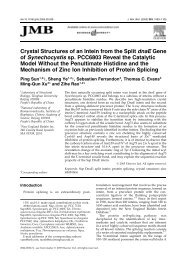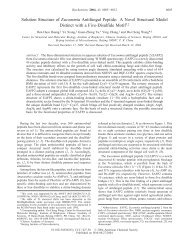Tryptophan fluorescence quenching by alkaline earth metal cations ...
Tryptophan fluorescence quenching by alkaline earth metal cations ...
Tryptophan fluorescence quenching by alkaline earth metal cations ...
You also want an ePaper? Increase the reach of your titles
YUMPU automatically turns print PDFs into web optimized ePapers that Google loves.
Journal of Photochemistry and Photobiology B: Biology 59 (2000) 38–41<br />
www.elsevier.nl/locate/jphotobiol<br />
<strong>Tryptophan</strong> <strong>fluorescence</strong> <strong>quenching</strong> <strong>by</strong> <strong>alkaline</strong> <strong>earth</strong> <strong>metal</strong> <strong>cations</strong> in<br />
deionized bacteriorhodopsin<br />
Guangyu Wang, Ao-Jin Wang, Kun-Sheng Hu*<br />
Institute of Biophysics, Academia Sinica, Beijing 100101, PR China<br />
Received 14 July 2000; accepted 3 November 2000<br />
Abstract<br />
<strong>Tryptophan</strong> <strong>quenching</strong> <strong>by</strong> the addition of <strong>alkaline</strong> <strong>earth</strong> <strong>metal</strong> <strong>cations</strong> to deionized bacteriorhodopsin suspensions was determined. The<br />
results show that the addition of cation primarily quenches <strong>fluorescence</strong> from surface tryptophan residues. The quenched intensity exhibits<br />
a1/R dependence, where R is the ionic radius of the corresponding <strong>metal</strong> ion. This observation results from a stronger energy transfer<br />
coupling between the tryptophan and the retinal. The membrane curvature may be involved as a result of <strong>cations</strong> motion and correlated<br />
conformational changes. © 2000 Elsevier Science B.V. All rights reserved.<br />
Keywords: Bacteriorhodopsin; Fluorescence <strong>quenching</strong>; Energy transfer coupling<br />
1. Introduction Trp residues [9,13,14]. Protein <strong>fluorescence</strong> studies<br />
showed that deionization causes an increase in emission<br />
Bacteriorhodopsin (bR) is a retinal-containing protein in intensity and a small bathochromic shift. The difference<br />
the purple membrane of Halobacterium halobium [1]. spectrum contains primarily emission at 333 nm, which<br />
Upon illumination, the protein undergoes a photocycle and could reflect the emission of surface tryptophan residues<br />
pumps protons across the cell membrane. The cumulative [15,16]. The <strong>quenching</strong> of the emission at 333 nm <strong>by</strong> all<br />
proton gradient drives ATP synthesis [2–4].<br />
<strong>metal</strong> <strong>cations</strong> was interpreted in terms of an energy transfer<br />
The bR protein contains eight tryptophan (Trp) and 11 coupling between tryptophans and retinal [17]. UV differtyrosine<br />
residues [5]. It has been proposed that all but one<br />
21<br />
ence spectra of the blue membrane upon Mn binding<br />
or two Trp residues are involved in an energy transfer indicated a charge perturbation of Trp residues [14]. The<br />
between the retinal chromophore and the Trp residues. neighboring charged species possibly involve a divalent<br />
Surface Trp residues such as Trp10, Trp12 or Trp137 were <strong>metal</strong> cation [18]. In this study <strong>alkaline</strong> <strong>earth</strong> <strong>metal</strong> <strong>cations</strong><br />
recently specified as the candidates for the unquenched or were employed to quench Trp <strong>fluorescence</strong> in the deionpartly<br />
quenched Trp residues [6].<br />
ized bR suspensions. Our results show that the addition of<br />
21 21<br />
The protein contains 4 mol of Ca and 1 mol of Mg cation primarily quenches <strong>fluorescence</strong> from surface Trp<br />
per mol of bR [7]. At neutral pH removal of these <strong>cations</strong> residues. The quenched <strong>fluorescence</strong> intensity exhibits a<br />
leads to a purple-to-blue color transition and eliminates 1/R dependence, where R is the crystal ionic radius of the<br />
proton pumping <strong>by</strong> inhibiting the Schiff base deprotonation corresponding <strong>metal</strong> cation. The feature could be explained<br />
[7,8]. On the other hand, the spectroscopic and photo- <strong>by</strong> the membrane curvature which causes a change in<br />
chemical properties of the protein can be restored <strong>by</strong> energy transfer between retinal and Trp residues.<br />
adding divalent <strong>cations</strong> to the deionized blue membrane<br />
suspensions [9–12].<br />
Several groups have demonstrated that removal of <strong>metal</strong> 2. Materials and methods<br />
<strong>cations</strong> causes a small conformational change around the<br />
Purple membrane was prepared from Halobacterium<br />
halobium strain RM<br />
1 1<br />
as previously described [19]. The<br />
*Corresponding author. Present address: Institute of Biophysics, 15<br />
Datun Road, Beijing 100101, PR China. Tel.: 186-10-6488-8580; fax: samples was then deionized passing purple membrane<br />
186-10-6487-7837.<br />
suspensions through a cation exchange column (Dowex<br />
E-mail address: huks1401@sun5.ibp.ac.cn (K.-S. Hu). 50W). Reionization was carried out <strong>by</strong> adding MgCl<br />
2,<br />
1011-1344/00/$ – see front matter © 2000 Elsevier Science B.V. All rights reserved.<br />
PII: S1011-1344(00)00132-9
G. Wang et al. / Journal of Photochemistry and Photobiology B: Biology 59 (2000) 38 –41 39<br />
CaCl<br />
2, SrCl2 and BaCl2<br />
to the deionized bR samples until<br />
no further spectral change could be detected. All the<br />
samples were light-adapted and measured at 5 mM based<br />
21 21<br />
on that ´<br />
605<br />
of the deionized bR is 60 000 M cm and<br />
21 21<br />
´<br />
568<br />
of the native bR is 63 000 M cm , where ´ is the<br />
molar extinction coefficient [9].<br />
Absorption spectra were measured on a Hitachi U-3200<br />
UV/Visible spectrometer and steady state <strong>fluorescence</strong><br />
spectra on a Hitachi F4500 spectrometer, where the<br />
excitation wavelength was set at 28065 nm. All the<br />
spectra were recorded at pH 5.5 and 258C.<br />
3. Results<br />
Fig. 1a shows the steady-state <strong>fluorescence</strong> emission<br />
spectra of bR. The bR emission band has a maximum at<br />
319 nm. The deionized bR gives a peak at 325 nm and its<br />
Fig. 2. Titration curves of the bR emission change as a function of added<br />
21 21 21 21<br />
divalent <strong>cations</strong>. j: Mg . d: Ca . m: Sr . .: Ba . The bR<br />
concentration is 5 mM. pH55.5.<br />
<strong>fluorescence</strong> intensity is about 30% higher than that of the<br />
21 21 21 21<br />
native sample. When four Mg , Ca , Sr or Ba per<br />
bR are added to the deionized bR suspension, most of the<br />
<strong>fluorescence</strong> is quenched (Fig. 2). The necessary salt<br />
concentration to level off is about 12 <strong>cations</strong> per bR.<br />
Fig. 1b shows Trp <strong>quenching</strong> <strong>by</strong> different <strong>alkaline</strong> <strong>earth</strong><br />
<strong>metal</strong> <strong>cations</strong> at concentration higher than 12 ions per bR.<br />
The difference spectrum of bR minus the deionized bR is a<br />
control. It is interesting that the quenched emission intensi-<br />
21 21 21<br />
ty is different. The effect order is Mg .Ca .Sr .<br />
21<br />
Ba . However, the shapes of the difference spectra are<br />
similar to that of the difference between bR and DbR.<br />
They all have a minimum at 333 nm. The emission around<br />
this wavelength could result from the <strong>fluorescence</strong> of a<br />
surface Trp residue [16,17].<br />
Compared to the emission of native bR, relative <strong>quenching</strong><br />
efficiencies of four kinds of <strong>metal</strong> <strong>cations</strong> in deionized<br />
bR are obtained. Fig. 3 shows that they are almost a linear<br />
function of wavelength from 300 to 390 nm. This suggests<br />
that the binding of <strong>cations</strong> in the deionized bR is similar to<br />
that in the native bR. Additionally, the decreasing order of<br />
21 21 21<br />
relative <strong>quenching</strong> efficiency is still Mg , Ca , Sr and<br />
21<br />
Ba . This is contrary to a change in their size [20]. When<br />
21 21 21<br />
relative <strong>quenching</strong> efficiencies of Ca , Sr and Ba<br />
ions are multiplied <strong>by</strong> their size and then divided <strong>by</strong><br />
21<br />
relative <strong>quenching</strong> efficiency of Mg multiplied <strong>by</strong> its<br />
size, three ratios of one are obtained between 300 and 390<br />
21<br />
nm within an error. Fig. 4 reveals a case about Ca . The<br />
others are very similar. This means that the quenched<br />
Fig. 1. (a) Steady state Trp <strong>fluorescence</strong> spectra of bR suspended in emission intensity depends on 1/R, where R is the ionic<br />
water. Successive spectra with decreasing amplitude correspond to the<br />
21 21 21<br />
deionized bR, Ba -regenerated bR, Sr -regenerated bR, Ca -regener- radius of the corresponding <strong>metal</strong> ion.<br />
21<br />
ated bR, Mg -regenerated bR, and native bR. The bR concentration is 5<br />
mM. pH55.5. The samples were excited at 28065 nm. (b) Fluorescence<br />
spectral change of deionized bR upon the addition of <strong>cations</strong> at con- 4. Discussion<br />
centration higher than 12 <strong>cations</strong> per bR. Successive spectra with<br />
21 21 21 21<br />
increasing amplitude correspond to Ba , Sr , Ca and Mg in the<br />
sample cuvette containing the DbR suspensions. The curve with the<br />
largest amplitude is the difference spectrum between native bR and<br />
deionized bR. The bR concentration is 5 mM. pH55.5.<br />
In this study all the mission spectra were recorded at a<br />
bR concentration of 5 mM, pH 5.5 and 258C. Under this<br />
conditions, the emitted light is only slightly reabsorbed <strong>by</strong>
40 G. Wang et al. / Journal of Photochemistry and Photobiology B: Biology 59 (2000) 38 –41<br />
ther indicated the conformational change perturbed the<br />
21<br />
tryptophan [14]. In addition, the addition of Ca to the<br />
ion-depleted and retinal-removed membrane does not<br />
affect <strong>fluorescence</strong> emission intensity [17]. These results<br />
suggest the <strong>quenching</strong> of the <strong>fluorescence</strong> emission <strong>by</strong><br />
<strong>alkaline</strong> <strong>earth</strong> <strong>metal</strong> <strong>cations</strong> is due to a stronger energy<br />
transfer coupling between the tryptophan and the retinal.<br />
Different energy transfer efficiencies may be due to a<br />
difference in their relative distance or orientation to retinal.<br />
It has been reported that the affinity of divalent <strong>metal</strong><br />
<strong>cations</strong> changes with their sizes. The smaller ions are more<br />
tightly bound to the membrane than larger ones [21,22].<br />
The different affinity would result in a different extent of<br />
13<br />
conformational change. On the other hand, C NMR<br />
studies show that the bound <strong>cations</strong> exchange rather<br />
rapidly among various types of cation binding sites [23].<br />
Fig. 3. Emission wavelength dependence of relative <strong>quenching</strong> efficiency<br />
Varo ´´ et al. also proposed that <strong>cations</strong> bind to a non-specific<br />
(Q) of the <strong>metal</strong> <strong>cations</strong> at concentration higher than 12 cation/bR.<br />
Successive curves with increasing amplitude at 333 nm correspond to site [24]. Therefore, cation motions and correlated con-<br />
21 21 21 21<br />
Ba , Sr , Ca and Mg in the sample cuvette containing the formational changes in the bR result in transient forces.<br />
deionized bR suspension. The bR concentration is 5 mM. pH55.5. These transient forces change the membrane curvature<br />
Relative <strong>quenching</strong> efficiency is calculated as Q 5 uIi2 Ibmu/uIbm2 Ipm u, [25]. Because of different affinities of divalent <strong>cations</strong> on<br />
where I<br />
bm, Ipm and Ii are relative emission intensity of deionized bR,<br />
the membrane, the membrane curvature would be different.<br />
native bR and cation-regenerated sample, respectively.<br />
The energy transfer efficiency is thus changed due to<br />
different distance between tryptophan and retinal and their<br />
ground-state bR molecules and the emission spectra that<br />
relative orientation.<br />
we recorded are not distorted <strong>by</strong> any internal filter effect,<br />
even <strong>by</strong> the high bR concentration [16]. In addition, at this<br />
concentration, the deionized bR samples are not easily<br />
reionized <strong>by</strong> minute traces of any cation and extreme care<br />
5. Abbreviations<br />
has not to be taken in order to keep a completely deionized<br />
suspension even for very short periods of time. What is<br />
bR Means bacteriorhodopsin<br />
more, the use of a higher bR concentration could help us<br />
Trp Means tryptophan<br />
get around the problem that the Raman emission from<br />
DbR Means deionized bacteriorhodopsin<br />
water at 298 nm induces a noticeable shoulder on the<br />
<strong>fluorescence</strong> band which makes measurements at wavelengths<br />
shorter than 310 nm questionable [16].<br />
Acknowledgements<br />
The circular dichroism studies show that the addition of<br />
cation to the deionized blue membrane changes the protein This work was funded <strong>by</strong> National Science Foundation<br />
conformation [9,13]. UV-difference spectrophotometry fur- of China and Grant for Key Program from Chinese<br />
Academy of Sciences (Grant Nos. Kj951-A1-501-05 and<br />
Kj952-S1-03).<br />
References<br />
[1] D. Oesterhelt, W. Stoecknius, Functions of a new photoreceptor<br />
membrane, Proc. Natl. Sci. USA 70 (1973) 2853–2857.<br />
[2] R.R. Birge, Nature of the primary photochemical events in rhodopsin<br />
and bacteriorhodopsin, Biochim. Biophys. Acta 1016 (1990)<br />
293–327.<br />
[3] M.A. El-Sayed, On the molecular mechanism of the solar to electric<br />
energy conversion <strong>by</strong> the other photosynthetic system in nature<br />
bacteriorhodopsin, Acc. Chem. Res. 25 (1992) 279–286.<br />
[4] J.K. Lanyi, Proton translocation mechnism and energetics in the<br />
light-driven pump bacteriorhodopsin, Biochim. Biophys. Acta 1183<br />
(1993) 241–261.<br />
21 21 21 21<br />
Fig. 4. Emission wavelength dependence of RCa Q<br />
Ca<br />
/RMgQ Mg, where R [5] O. Kalisky, J. Feitelson, M. Ottelenghi, Photochemistry and fluoresis<br />
the ionic radius of the corresponding cation, Q is relative <strong>quenching</strong><br />
cence of bacteriorhodopsin excited in its 280 nm absorption band,<br />
efficiency of the cation. Biochemistry 20 (1981) 205–209.
G. Wang et al. / Journal of Photochemistry and Photobiology B: Biology 59 (2000) 38 –41 41<br />
[6] M. Roy, N. Periasamy, Resolution of spectral and lifetime hetero- [15] B.J. Plotkin, W.V. Sherman, Spectral heterogeneity in protein fluoresgeneity<br />
of tryptophan <strong>fluorescence</strong> in bacteriorhodopsin, Photochem. cence of bacteriorhodopsin: evidence for intraprotein aqueous<br />
Photobiol. 61 (1995) 292–297. regions, Biochemistry 23 (1984) 5353–5360.<br />
[7] C.H. Chang, J.-G. Chen, R. Govindjee, T.G. Ebrey, Cation binding [16] G. Mercier, P. Dupuis, The effects of deionization on the protein<br />
<strong>by</strong> bacteriorhodopsin, Proc. Natl. Acad. Sci. USA 82 (1985) 396– <strong>fluorescence</strong> of bacteriorhodopsin, Photochem. Photobiol. 47 (1988)<br />
400. 433–438.<br />
[8] S. Subramaiam, T. Marti, H.G. Khorana, Protonation state of Asp [17] D.J. Jang, T.L. Corcorm, M.A. El-Sayed, Effects of <strong>metal</strong> <strong>cations</strong>,<br />
(Glu)-85 regulates the purple-to-blue transition in bacteriorhodopsin<br />
retinal, and the photocycle on the tryptophan emission in bacteriomutants<br />
Arg-82Ala and asp-85Glu: the blue form is inactive in rhodopsin, Photochem. Photobiol. 48 (1988) 209–217.<br />
proton translocation, Proc. Natl. Acad. Sci. USA 87 (1990) 1013– [18] S. Wu, D.J. Jang, M.A. El-Sayed, T. Marti, T. Mogi, H.G. Khorana,<br />
1017. The use of tryptophan mutants in identifying the 296 nm transient<br />
[9] Y. Kimura, A. Ikegami, W. Stoeckenius, Salt and pH-dependent absorbing species during the photocycle of bacteriorhodopsin, FEBS<br />
changes of the purple membrane absorption spectrum, Photochem. Lett. 284 (1991) 9–14.<br />
Photobiol. 40 (1984) 641–646.<br />
[19] D. Oesterhelt, W. Stoeckenius, Isolation of the cell membrane of<br />
[10] C.H. Chang, R. Jonas, S. Melchiore, R. Gorvindjee, T.G. Ebrey, Halobacterium halobium and its fraction into red and purple<br />
Mechansim and role of divalent cation binding of bacteriorhodopsin, membrane, Methods Enzymol. 31 (1974) 667–678.<br />
Biophys. J. 49 (1986) 731–739.<br />
[20] R.C. Weast, in: CRC Handbook of Chemistry and Physics, 61st<br />
[11] M. Dunach, ˜ M. Seigneuret, J.-L. Rigaud, E. Padros, ´ Characterization Edition, CRC Press, Boca Raton, FL, 1980, p. F217.<br />
of the cation binding sites of the purple membrane. Electron spin [21] M. Ariki, J.K. Lanyi, Characterization of <strong>metal</strong> ion-binding sites in<br />
resonance and flash photolysis studies, Biochemistry 26 (1987) bacteriorhodopsin, J. Biol. Chem. 261 (1986) 8167–8174.<br />
1179–1186. [22] S.K. Yoo, E.S. Awad, M.A. El-Sayed, Comparision between the<br />
[12] Y.N. Zhang, L.L. Sweetman, E.S. Awad, M.A. El-Sayed, Nature of<br />
21<br />
binding of Ca<br />
21<br />
and Mg to the two high-affinity sites of<br />
21<br />
the individual Ca<br />
21<br />
binding sites in Ca -regenerated bacterio- bacteriorhodopsin, J.Phys. Chem. 99 (1995) 11600–11604.<br />
rhodopsin, Biophys. J. 61 (1992) 1201–1206. [23] S. Tuzi, S. Yamaguchi, M. Tanio, H. Konishi, S. Inoue, A. Naito, R.<br />
[13] M.P. Heyn, C. Dudda, H. Otto, F. Seiff, I. Wallat, The purple to blue Needleman, J.K. Lanyi, H. Saito, ˆ Location of a cation-binding site<br />
transition of bacteriorhodopsin is accompanied <strong>by</strong> a loss of the<br />
in the loop between helices F and G of bacteriorhodopsin as studied<br />
hexagonal lattice and a conformational changes, Biochemistry 28<br />
13<br />
<strong>by</strong> C NMR, Biophys. J. 76 (1999) 1523–1531.<br />
(1989) 9166–9172. [24] G. Varo, ´´ L.S. Brown, R. Needleman, J.K. Lanyi, Binding of calcium<br />
[14] M. Dunach, ˜ E. Padros, ´ M. Seigneuret, J.-L. Rigaud, On the ions to bacteriorhodopsin, Biophys. J. 76 (1999) 3219–3226.<br />
molecular mechanism of the blue to purple transition of bacterio- [25] J. Czege, ´ ´ L. Reinisch, The pH dependence of transient changes in<br />
rhodopsion. UV-difference spectroscopy and electron spin resonance the curvature of the purple membrane, Photochem. Photobiol. 54<br />
studies, J. Biol. Chem. 263 (1988) 7555–7559. (1991) 923–930.








